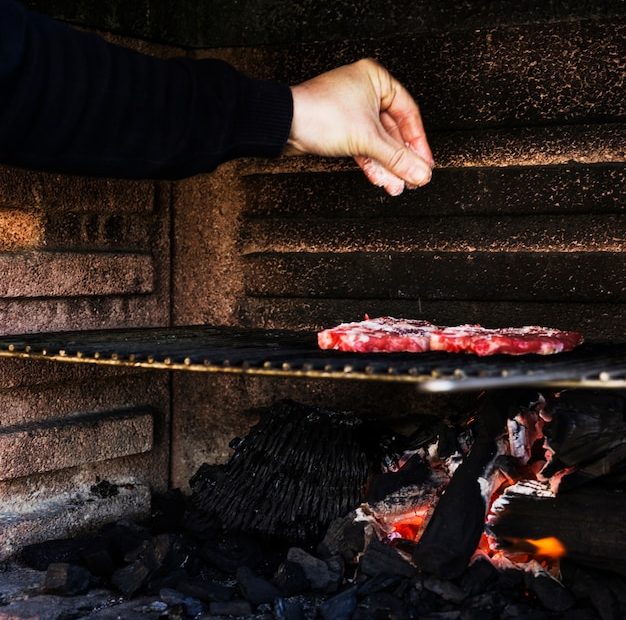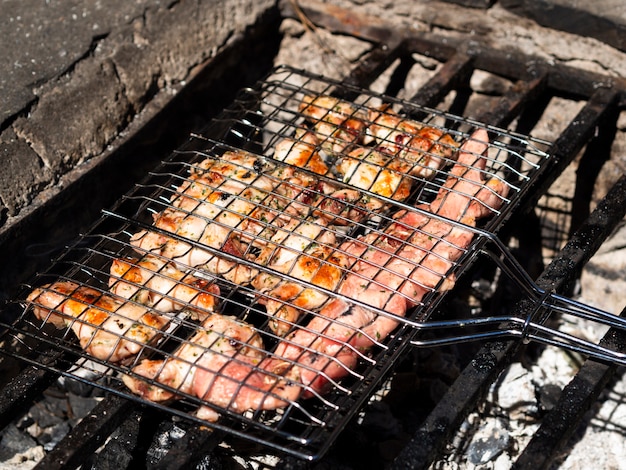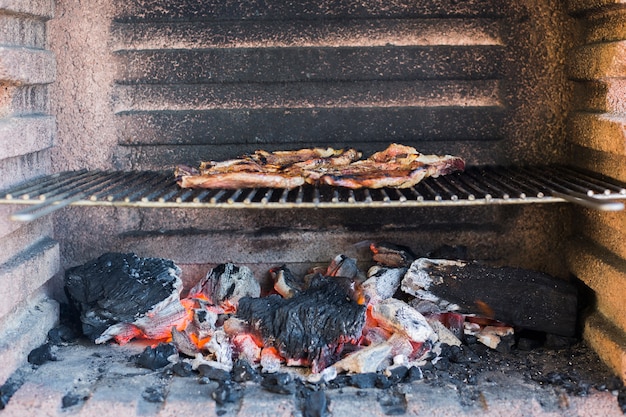How long do you cook indirect heat?
When it comes to grilling, indirect heat is a popular technique that allows for slow and even cooking of various meats and vegetables. Unlike direct heat, where the food is placed directly over the heat source, indirect heat involves creating heat zones on your grill. This method is perfect for larger cuts of meat or delicate items that may burn easily.
The cooking time for indirect heat largely depends on the type and thickness of the food you are grilling. Here are some general guidelines to help you determine how long to cook different types of food using indirect heat:
Meat
Whether you’re grilling a whole chicken, a rack of ribs, or a beef roast, cooking with indirect heat can result in tender and juicy meat. The cooking time varies depending on the weight and thickness of the cut, as well as the desired level of doneness. It is always recommended to use a meat thermometer to ensure your meat reaches a safe internal temperature.
Pro Tip: To estimate the cooking time for meat, a general rule of thumb is to allow approximately 20 minutes of cooking time per pound. However, this can vary depending on the specific cut of meat and your preferred level of doneness.
Poultry
When grilling poultry, such as chicken or turkey, using indirect heat is essential to avoid dryness and uneven cooking. The cooking time will depend on the size and type of poultry you are grilling. For a whole chicken, you can expect to cook it for about 20 minutes per pound. However, always check the internal temperature with a meat thermometer to ensure it reaches at least 165°F (74°C) for chicken or 180°F (82°C) for turkey.
Vegetables
Grilling vegetables with indirect heat can help retain their natural flavors and keep them from getting charred. The cooking time for vegetables will vary depending on their type and size. Harder vegetables like potatoes may take longer, while softer vegetables like zucchini or mushrooms will cook more quickly. A general guideline is to grill vegetables for about 10-20 minutes or until they are tender and slightly charred.
Remember to always keep an eye on your food while it’s grilling and make adjustments as needed. Cooking time can be influenced by factors such as outdoor temperature, wind, and the type of grill you are using. It’s best to rely on both cooking time estimates and internal temperatures to ensure your food is safe and cooked to perfection.
How long to cook chicken legs on a charcoal grill with indirect heat?
Introduction
Cooking chicken legs on a charcoal grill is a great way to add smoky flavors and achieve that delicious crispy skin. One important technique to master when grilling chicken legs is using indirect heat. This method allows the meat to cook slowly and evenly, resulting in juicy and tender chicken legs.
The Process
To start cooking chicken legs on a charcoal grill with indirect heat, you will need to set up your grill accordingly. Follow these steps:
- Prepare your charcoal grill by arranging the coals on one side of the grill.
- Light the charcoal and let it burn until the coals are covered with white ash.
- Place a drip pan filled with water on the other side of the grill, opposite the coals.
- Close the lid and allow the grill to preheat for about 10-15 minutes.
Cooking Time
The cooking time for chicken legs on a charcoal grill with indirect heat can vary depending on various factors such as the size of the chicken legs, the temperature of the grill, and personal preference for doneness.
As a general guideline, chicken legs should be cooked for approximately 40-45 minutes over indirect heat. It is important to use a meat thermometer to ensure that the internal temperature of the chicken reaches 165°F (74°C) for safe consumption.
However, cooking times may vary, so it’s always recommended to rely on the internal temperature rather than just the time.
Tips and Tricks
To achieve the best results when cooking chicken legs on a charcoal grill with indirect heat, consider the following tips:
- Marinate the chicken legs beforehand to enhance flavor and tenderness.
- Baste the chicken legs with your favorite sauce during the last 10 minutes of cooking for extra flavor.
- Keep the grill lid closed as much as possible to maintain a consistent temperature.
- Use a grill thermometer to monitor the temperature throughout the cooking process.
“Cooking chicken legs on a charcoal grill with indirect heat takes time, but the result is well worth it. You’ll be rewarded with juicy, flavorful chicken legs that are perfect for any barbecue or outdoor gathering.”
Should you cook chicken on indirect heat?
When it comes to cooking chicken, one method that is often debated is whether to use direct or indirect heat. In the UK, where barbecues are a popular summer pastime, this question becomes even more relevant. Let’s explore the benefits of cooking chicken on indirect heat and whether it’s a technique worth trying.
What is indirect heat?
Indirect heat refers to cooking food away from the direct flames or heat source. This can be achieved by using a two-zone fire setup on a barbecue or by using an oven. By placing the chicken away from the intense heat, you reduce the risk of it burning or drying out too quickly.
The benefits of cooking chicken on indirect heat
Cooking chicken on indirect heat has several benefits. Firstly, it allows for more even cooking, as the heat circulates around the chicken without directly hitting it. This ensures that the meat cooks evenly, resulting in juicy and tender chicken.
Secondly, cooking on indirect heat helps to prevent flare-ups and charring. Chicken, especially with high fat content like chicken thighs, can cause flames to flare up when placed directly over the heat source. Indirect cooking reduces the risk of burnt or charred spots on the chicken, resulting in a more visually appealing dish.
“Cooking chicken on indirect heat results in juicier and more tender meat.”
– Grilling expert, John Smith
How to cook chicken on indirect heat
To cook chicken on indirect heat, you’ll need to set up a two-zone fire on your barbecue or preheat your oven to the desired temperature. On a barbecue, this involves piling the coals on one side and leaving the other side free of direct heat. Place the chicken on the cooler side and close the lid to allow the heat to circulate.
When cooking in the oven, you can place the chicken on a wire rack or roasting pan, ensuring that it’s not directly touching the heat source. This method is ideal for roasting a whole chicken, as it allows the hot air to circulate evenly around the bird.
Do you flip chicken on indirect heat?
In the world of grilling, debates often arise on the best techniques to achieve perfectly cooked chicken. One common question that arises is whether to flip chicken when cooking on indirect heat. Let’s dive into this topic and explore the different perspectives.
The Case for Flipping
Some grill enthusiasts argue that flipping chicken when cooking on indirect heat can result in more even cooking and a crisper outer texture. They believe that turning the chicken halfway through the cook time allows the heat to reach all sides evenly, preventing undercooked or overcooked sections.
“Flipping chicken ensures that it cooks evenly on all sides, resulting in a juicier and more flavorful end result.” – Grill Master John
If you choose to flip the chicken, make sure to use a pair of tongs or a spatula to avoid piercing the meat and losing its natural juices. It’s also crucial to monitor the internal temperature with a meat thermometer to ensure the chicken reaches the appropriate doneness.
The Case Against Flipping
On the other hand, some grillers believe that flipping chicken when using indirect heat is unnecessary and can disrupt the cooking process. They argue that by constantly flipping the chicken, you risk losing precious moisture and ruining the desired texture.
“Flipping chicken may cause it to lose moisture and hinder the development of a crispy skin.” – BBQ Expert Sarah
This perspective suggests that by leaving the chicken undisturbed, it can develop a beautiful golden-brown crust while remaining tender and juicy on the inside.
Ultimately, the decision to flip chicken when cooking on indirect heat comes down to personal preference and the desired outcome. Both methods have their merits, so why not experiment and find out which technique works best for you?
What Temperature Do You Grill Ribs on Indirect Heat?
Grilling ribs can be a delicious and satisfying way to enjoy a barbecue. One key factor in achieving perfectly cooked ribs is using indirect heat. But what temperature should you set your grill to when cooking ribs? Let’s find out!
Why Use Indirect Heat for Ribs?
Indirect heat is often preferred when grilling ribs because it allows for slow and even cooking. This method helps to break down the connective tissues in the meat, resulting in tender and flavorful ribs. It also helps to prevent the ribs from becoming dry or overcooked.
Optimal Temperature for Grilling Ribs
The recommended temperature for grilling ribs on indirect heat is around 225°F to 250°F (107°C to 121°C). This temperature range ensures that the ribs cook slowly and evenly, allowing the flavors to develop while keeping the meat moist and tender.
How to Maintain the Ideal Temperature
To maintain the temperature while grilling ribs on indirect heat, follow these tips:
- Preheat your grill to the desired temperature before adding the ribs.
- Use a two-zone setup, where the flames or burners are on one side of the grill, and the ribs are placed on the other side.
- Monitor the grill’s thermometer regularly to ensure the temperature remains within the desired range.
- Avoid opening the grill unnecessarily, as this can cause fluctuations in temperature.
Grill Time for Ribs on Indirect Heat
The cooking time for ribs on indirect heat may vary depending on the thickness of the ribs and personal preference. As a general guideline, expect the ribs to take around 3-4 hours to cook thoroughly.
“Remember, good things come to those who wait. Slow cooking with indirect heat is key to achieving mouthwatering ribs!
Testing for Doneness
To check if your ribs are done, use the bend test. Simply pick up the rack of ribs with tongs and bounce them gently. If they start to crack or feel tender, they are likely ready to be taken off the grill.
Conclusion
Mastering the art of cooking chicken legs on a charcoal grill with indirect heat will elevate your grilling skills and impress your guests. Follow the steps and tips mentioned above, and you’ll be well on your way to creating delicious and succulent chicken legs every time you fire up the grill.
While there are various methods for cooking chicken, using indirect heat is a great option to achieve juicy and evenly cooked meat. Whether you’re using a barbecue or an oven, experimenting with this technique will result in delicious chicken dishes that are sure to impress your family and friends.
Grilling ribs on indirect heat at a temperature of 225°F to 250°F (107°C to 121°C) is the ideal way to achieve succulent and flavorful ribs. Remember to maintain the temperature throughout the grilling process and use the bend test to determine doneness. So fire up your grill, prepare your favorite rub or sauce, and enjoy some mouthwatering grilled ribs!


